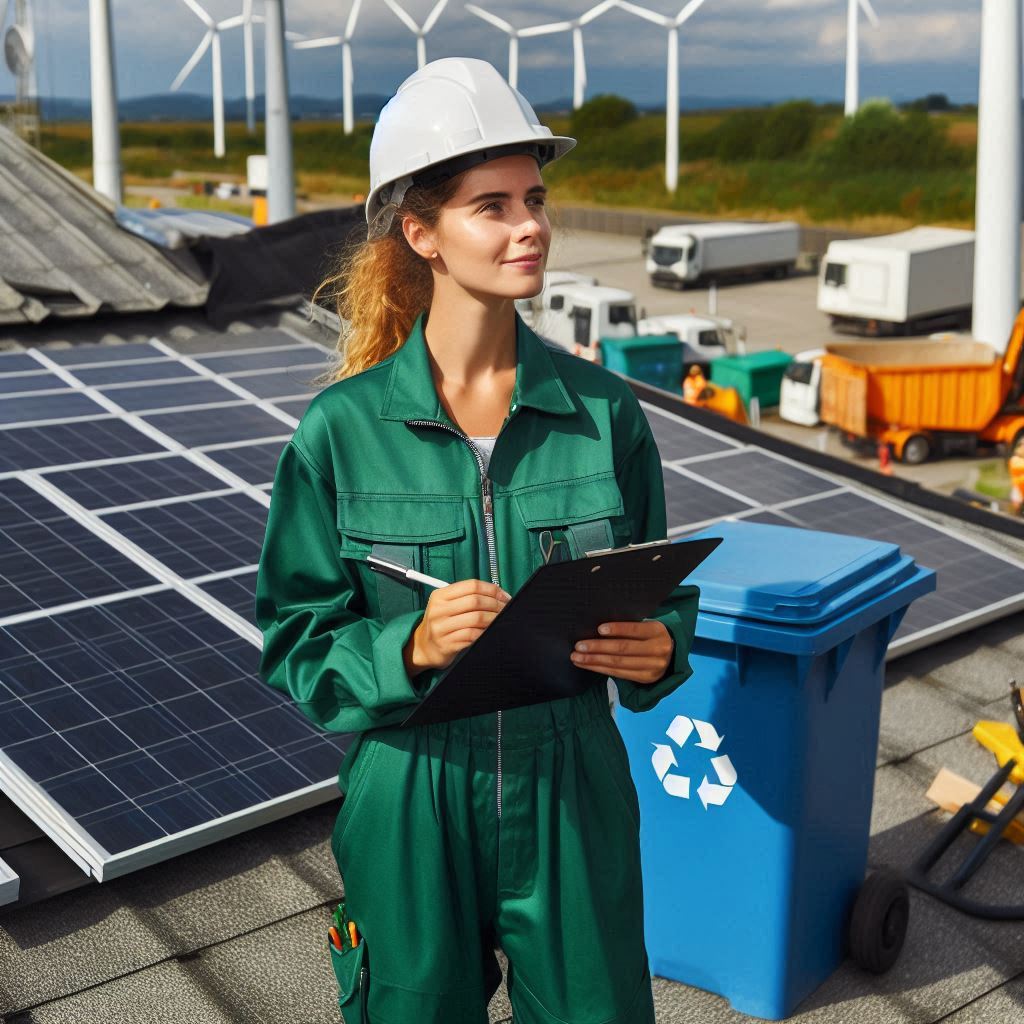Introduction
An environmental technician is a professional dedicated to monitoring and protecting the environment as Environmental Technician in Conservation Efforts.
They conduct fieldwork and laboratory analysis to assess environmental conditions.
Their tasks include collecting samples, performing tests, and analyzing data to identify environmental issues.
Environmental technicians play a crucial role in conservation efforts.
They help protect natural resources by monitoring ecosystems and tracking environmental changes.
Their work ensures that conservation strategies are based on accurate data and scientific evidence.
Technicians assess the health of habitats, manage wildlife populations, and support habitat restoration projects.
Technicians regularly monitor ecosystems to detect changes and threats.
They collect and analyze samples from soil, water, and air.
This data helps identify pollution sources, invasive species, and other factors affecting ecosystems.
Early detection of issues allows for timely intervention and management.
In conservation, technicians also support habitat restoration projects.
They evaluate damaged areas and develop strategies for rehabilitation.
Their expertise ensures that restoration efforts are effective and sustainable, promoting the recovery of native species and habitats.
Environmental technicians are vital to conservation efforts.
Their work in monitoring ecosystems and supporting restoration projects ensures effective environmental protection.
By providing critical data and expertise, they help maintain biodiversity and promote sustainable practices.
Responsibilities of an Environmental Technician
An environmental technician plays a crucial role in conservation efforts by performing various tasks and responsibilities to protect and preserve the environment.
Let’s delve into the key responsibilities of an environmental technician in more detail:
Conducting Field Surveys and Data Collection
One of the primary responsibilities of an environmental technician is to conduct field surveys to assess the environmental quality of a specific area.
This involves collecting samples, monitoring wildlife, and documenting the ecosystem’s health.
By conducting thorough field surveys, environmental technicians can gather valuable data that helps in understanding the overall condition of the environment.
These surveys are essential for identifying potential threats to biodiversity, water quality, and air pollution levels.
Analyzing Data to Identify Environmental Issues
Once the data is collected from field surveys, environmental technicians analyze the information to identify environmental issues and potential hazards.
They use various tools and software to process the data, create reports, and visualize trends that can help in assessing the impact of human activities on the environment.
By analyzing data effectively, environmental technicians can pinpoint specific areas that require immediate attention and develop strategies to mitigate environmental risks.
Developing and Implementing Conservation Plans
Based on the findings from field surveys and data analysis, environmental technicians are responsible for developing conservation plans to protect natural resources and promote sustainability.
These conservation plans outline specific goals, objectives, and actions that need to be taken to preserve the environment and minimize negative impacts.
Environmental technicians work closely with government agencies, non-profit organizations, and other stakeholders to implement conservation plans effectively.
This may involve collaborating with scientists, policymakers, and community members to ensure that conservation efforts are carried out successfully.
The role of an environmental technician in conservation efforts is multifaceted and vital for maintaining ecological balance and biodiversity.
By conducting field surveys, analyzing data, and developing conservation plans, environmental technicians contribute significantly to protecting the environment and ensuring a sustainable future for generations to come.
Read: CAD Technician vs. Draftsman: Key Differences
Role in Water Conservation
Monitoring Water Quality and Usage
Environmental technicians play a crucial role in monitoring water quality and usage.
They regularly test water sources for pollutants and contaminants.
Technicians collect samples from rivers, lakes, and reservoirs to ensure water safety.
They measure parameters such as pH, turbidity, and chemical concentrations.
By tracking these metrics, they detect changes that could indicate pollution.
Monitoring water usage helps identify patterns and areas where conservation efforts are needed.
Implementing Strategies to Reduce Water Waste
Technicians also focus on implementing strategies to reduce water waste.
They assess water usage in various sectors, including residential, industrial, and agricultural.
By identifying inefficient practices, they recommend improvements to reduce consumption.
Technicians work with facilities to install water-saving technologies such as low-flow fixtures and leak detection systems.
They also promote practices like rainwater harvesting and wastewater recycling.
Their goal is to optimize water use and minimize waste.
Educating the Public on Water Conservation Practices
Education is a vital component of a technician‘s role in water conservation.
They develop and conduct outreach programs to raise awareness about water conservation.
Technicians create informative materials, such as brochures and online resources, to educate the public.
They organize workshops and seminars to teach effective water-saving techniques.
These programs often cover topics like reducing household water use, fixing leaks, and choosing water-efficient appliances.
Technicians also collaborate with schools and community organizations to spread conservation messages.
They may participate in local events to engage with the public and demonstrate water-saving practices.
By fostering a culture of conservation, technicians help people understand the importance of protecting water resources.
Overall, environmental technicians are essential in monitoring water quality, reducing waste, and educating the community.
Their efforts help ensure sustainable water management and contribute to the protection of vital water resources.
Read: CAD Technician Certification: What You Need to Know
Impact on Air Quality
Monitoring Air Pollution Levels
Environmental technicians play a critical role in monitoring air pollution levels.
They use specialized equipment to measure pollutants in the air.
Technicians collect data on various air quality parameters, including particulate matter, nitrogen dioxide, and sulfur dioxide.
Regular monitoring helps track changes in air quality over time.
Technicians place air sampling stations in strategic locations to gather representative data.
They ensure that equipment is properly calibrated for accurate readings.
Analyzing this data helps identify pollution trends and assess the effectiveness of air quality regulations.
Identifying Sources of Pollution
Identifying sources of air pollution is a key responsibility for environmental technicians.
They investigate potential emission sources, such as industrial facilities, vehicle exhaust, and construction sites.
Technicians conduct field surveys to determine where pollutants are being released into the atmosphere.
They use data from air monitoring to trace pollution back to its source.
Understanding these sources helps in pinpointing specific contributors to poor air quality.
Technicians may also collaborate with other agencies to gather additional information and confirm findings.
Identifying and quantifying sources of pollution is essential for developing effective control strategies.
Implementing Measures to Improve Air Quality
Once pollution sources are identified, environmental technicians work on implementing measures to improve air quality.
They help design and recommend strategies for reducing emissions.
This can include suggesting technological upgrades for industrial processes or advocating for cleaner fuels.
Technicians may also support the development of regulatory measures and policies aimed at controlling air pollution.
Public awareness campaigns and educational programs often form part of their efforts to promote air quality improvements.
They assist in enforcing regulations by monitoring compliance and reporting violations.
Technicians may work with community organizations to implement local air quality improvement projects.
In addition, technicians help evaluate the effectiveness of air quality measures by analyzing follow-up data.
They assess whether implemented strategies have achieved the desired outcomes and make recommendations for further improvements.
This ongoing evaluation ensures that air quality management efforts remain effective and responsive to changing conditions.
Environmental technicians play a vital role in air pollution control.
They monitor pollution levels, identify sources, and implement measures to improve air quality.
Their work involves collecting and analyzing data, investigating emission sources, and recommending strategies for reducing pollution.
By performing these tasks, technicians help ensure cleaner air and a healthier environment.
Read: Essential Skills for CAD Technicians

Contribution to Wildlife Conservation
Environmental technicians play a vital role in conservation efforts.
They are crucial in surveying wildlife populations, identifying threats to habitats, and implementing restoration projects. Here‘s a detailed look at their responsibilities.
Surveying and Monitoring Wildlife Populations
Technicians conduct surveys to track and assess wildlife populations. They use various methods to gather data:
- Field Surveys: Technicians perform on-site observations to count and record wildlife. These surveys provide baseline data on population sizes.
- Camera Traps: Automated cameras capture images of wildlife in their natural habitats. These images help monitor species presence and behavior.
- Tracking Devices: GPS collars and tags track the movements of animals. They provide insights into migration patterns and habitat use.
- Acoustic Monitoring: Devices record animal sounds to study vocal behaviors and population dynamics. This method is useful for monitoring elusive species.
Accurate data collection is essential for understanding wildlife trends and informing conservation strategies.
Identifying Threats to Wildlife Habitats
Technicians assess and identify various threats to wildlife habitats. They focus on:
- Habitat Destruction: Technicians evaluate the impact of deforestation, urbanization, and agriculture. They document how these activities reduce available habitats.
- Pollution: They monitor pollution levels in air, water, and soil. Pollution can affect wildlife health and disrupt ecosystems.
- Invasive Species: Technicians identify non-native species that threaten local wildlife. Invasive species can outcompete native species and alter habitat conditions.
- Climate Change: They study how climate change affects habitat conditions and species survival. Changes in temperature and weather patterns can impact wildlife.
Identifying these threats allows for the development of targeted conservation measures.
Implementing Habitat Restoration Projects
Restoring degraded habitats is crucial for wildlife conservation. Technicians are involved in various restoration activities:
Transform Your Career Today
Unlock a personalized career strategy that drives real results. Get tailored advice and a roadmap designed just for you.
Start Now- Revegetation: They plant native vegetation to restore plant communities. This helps rebuild natural habitats and supports wildlife.
- Erosion Control: Techniques like planting ground cover and building barriers prevent soil erosion. Erosion can lead to habitat loss and degradation.
- Wetland Restoration: Technicians work to restore wetlands by removing invasive plants and reestablishing natural water flow. Wetlands provide essential habitat for many species.
- Habitat Creation: They create new habitats by building features like nesting boxes or artificial ponds. These additions support species that need specific habitat conditions.
Effective habitat restoration improves the chances of wildlife survival and ecosystem health.
Read: Day in the Life of a CAD Technician
Involvement in Waste Management
Developing Waste Reduction and Recycling Programs
Environmental technicians play a key role in developing waste reduction and recycling programs. They help create strategies to minimize waste and increase recycling efforts.
Designing Programs
Technicians design programs to reduce waste at the source.
They assess waste generation patterns and identify reduction opportunities.
Developing recycling initiatives involves setting up collection systems and sorting procedures.
Technicians also collaborate with businesses and communities to implement these programs effectively.
Clear communication about recycling benefits encourages participation and compliance.
Implementing Strategies
Implementing waste reduction strategies requires careful planning and execution.
Technicians oversee the installation of recycling bins and waste separation facilities.
They also train staff and community members on proper recycling practices.
Monitoring program effectiveness helps in refining and improving strategies.
Technicians analyze data to measure success and make necessary adjustments.
Monitoring Landfill Sites and Waste Disposal Practices
Monitoring landfill sites and waste disposal practices is crucial for environmental protection.
Technicians ensure that waste management practices comply with regulations and minimize environmental impact.
Inspecting Landfill Sites
Technicians regularly inspect landfill sites for compliance with environmental regulations.
They monitor for potential leaks or contamination issues.
Proper waste containment and treatment are essential to prevent soil and water contamination.
Technicians also check for correct waste compaction and cover practices to control odors and pests.
Evaluating Disposal Practices
Evaluating waste disposal practices helps identify areas for improvement.
Technicians review how waste is sorted and processed before disposal.
They ensure that hazardous materials are handled correctly and disposed of safely.
Regular audits help maintain compliance with environmental standards and best practices.
Technicians provide recommendations for optimizing waste management operations.
Promoting Sustainable Waste Management Practices
Promoting sustainable waste management practices is essential for long-term environmental conservation.
Technicians advocate for methods that reduce waste and support recycling.
Educating the Public
Education is a key component of promoting sustainability.
Technicians conduct workshops and outreach programs to raise awareness about waste management.
They provide information on the benefits of reducing, reusing, and recycling.
Effective communication strategies help change behaviors and encourage community involvement.
Supporting Policy Development
Technicians support the development of policies that promote sustainable waste management.
They provide data and insights to inform policy decisions.
Technicians advocate for regulations that encourage waste reduction and recycling.
Collaborating with policymakers helps create effective waste management frameworks.
Encouraging Innovation
Encouraging innovation in waste management practices leads to more effective solutions.
Technicians explore new technologies and methods for waste reduction and recycling.
They stay updated on industry trends and advancements.
Supporting innovative approaches helps improve overall waste management efficiency.
Therefore, environmental technicians play a crucial role in conservation efforts by developing waste reduction and recycling programs.
They monitor landfill sites and waste disposal practices to ensure compliance and minimize impact.
Promoting sustainable waste management practices through education, policy support, and innovation further enhances environmental protection.
Their work contributes significantly to a more sustainable and healthier environment.
Collaboration with Government Agencies
Working closely with environmental regulatory agencies
Environmental technicians play a crucial role in conservation by working with regulatory agencies, supporting policy development, and ensuring compliance with environmental laws.
Their expertise and data are vital for effective environmental protection.
Environmental technicians work closely with environmental regulatory agencies to monitor and manage natural resources.
They provide essential data on air, water, and soil quality.
Technicians assist agencies by conducting field surveys, collecting samples, and analyzing environmental conditions.
Their accurate reporting supports informed decision-making and regulatory actions.
Effective communication with these agencies ensures that conservation efforts align with current regulations and standards.
Providing data and expertise for policy development
Technicians contribute valuable data and expertise to the development of environmental policies.
They analyze environmental trends and report findings that influence policy decisions.
By presenting clear and comprehensive data, they help policymakers understand the impacts of proposed regulations.
Technicians may also participate in drafting policy recommendations based on their technical insights.
Their work helps ensure that policies are grounded in scientific evidence and address critical environmental issues.
Ensuring Compliance with Environmental Laws
Ensuring compliance with environmental laws is a core responsibility for environmental technicians.
They monitor activities and enforce regulations designed to protect natural resources.
Technicians inspect facilities, review environmental impact assessments, and verify adherence to legal standards.
When non-compliance is identified, they report violations and recommend corrective actions.
Their vigilance helps prevent environmental damage and promotes sustainable practices.
Data Collection and Analysis
Accurate data collection and analysis are essential for effective environmental management.
Technicians gather data on pollutants, habitat conditions, and resource usage.
They use advanced analytical tools to assess the data and identify trends.
This information is critical for evaluating environmental impacts and developing mitigation strategies.
Reliable data supports evidence-based decision-making and helps ensure that conservation efforts are effective.
Reporting and Documentation
Documenting findings and reporting to regulatory agencies is a key part of a technician’s role.
Detailed reports provide transparency and accountability in environmental management.
Technicians must maintain accurate records of their observations, analyses, and recommendations.
Proper documentation supports regulatory compliance and facilitates audits and reviews.
Training and Professional Development
Continuous training and professional development are important for technicians to stay current with regulations and technologies.
Attending workshops, conferences, and training programs helps them stay informed about best practices and regulatory changes.
Ongoing education enhances their skills and effectiveness in supporting conservation efforts.
Showcase Your Business Today
Reach thousands of readers actively exploring professional services. Publish your business profile and grow your audience now.
Publish NowEnhancing Public Awareness
Technicians also contribute to public awareness by sharing information about environmental issues and regulations.
They may participate in community outreach programs or educational events.
By increasing public understanding, technicians help foster a culture of environmental responsibility and support for conservation initiatives.
Environmental technicians are integral to conservation efforts through their collaboration with regulatory agencies, support for policy development, and enforcement of environmental laws.
Their expertise in data collection, reporting, and compliance ensures effective environmental protection and sustainable resource management.
By staying informed and engaging with the public, technicians play a vital role in advancing conservation goals and promoting environmental stewardship.
Delve into the Subject: Aerospace Engineering Degree Requirements
Importance of Public Outreach
As an environmental technician involved in conservation efforts, public outreach plays a crucial role in creating awareness, driving change, and fostering collaboration.
Here are some key points highlighting the importance of public outreach:
Educating the community on environmental issues
One of the primary roles of an environmental technician in conservation efforts is to educate the community about various environmental issues.
This involves explaining the importance of conservation, the impact of human activities on the environment, and the need for sustainable practices.
By raising awareness about environmental issues such as pollution, deforestation, climate change, and endangered species, environmental technicians can help individuals understand the relevance of conservation efforts and motivate them to take action.
Encouraging sustainable behavior change
Public outreach also aims at encouraging sustainable behavior change among community members.
Environmental technicians can do this by providing information on eco-friendly practices, sharing tips on energy conservation, waste reduction, and water preservation.
Through workshops, campaigns, and community events, environmental technicians can inspire people to adopt sustainable habits in their daily lives.
This includes recycling, using environmentally friendly products, reducing carbon footprint, and supporting local conservation initiatives.
Building partnerships with local organizations and schools
Another crucial aspect of public outreach is building partnerships with local organizations, schools, and community groups.
By collaborating with these stakeholders, environmental technicians can amplify their impact, reach a wider audience, and mobilize resources for conservation projects.
Working with schools allows environmental technicians to engage with students, teachers, and parents to instill environmental values, promote outdoor learning, and empower the next generation of environmental stewards.
This can include organizing field trips, workshops, and nature-based activities to foster a sense of environmental responsibility.
Partnering with local organizations, such as environmental NGOs, wildlife reserves, and government agencies, enables environmental technicians to leverage expertise, share best practices, and coordinate efforts for larger conservation initiatives.
This can involve joint campaigns, research projects, and community events to address pressing environmental issues collaboratively.
Public outreach is a vital component of an environmental technician’s role in conservation efforts.
By educating the community, promoting sustainable behavior change, and building partnerships with local organizations and schools, environmental technicians can make a positive impact on the environment and inspire collective action for a greener, more sustainable future.
See Related Content: Agricultural Engineering vs. Agricultural Science
Conclusion
Environmental technicians play a crucial role in conservation efforts.
They monitor ecosystems, track wildlife populations, and assess habitat conditions.
Technicians collect and analyze data to understand environmental changes and impacts.
They also support conservation projects by implementing best practices and managing resources effectively.
Their work helps preserve biodiversity and maintain ecological balance.
Technicians’ contributions are essential for effective conservation.
Their data guides policy decisions and conservation strategies.
By identifying threats and monitoring progress, they help ensure that conservation efforts are successful.
Their expertise supports habitat restoration, pollution control, and sustainable resource management.
Technicians are on the front lines of environmental protection, addressing challenges and fostering resilience in ecosystems.
It is vital to support and recognize environmental technicians for their work.
Adequate funding and resources are necessary for their continued success.
Public and institutional recognition can boost morale and validate their contributions.
Acknowledging their efforts encourages continued dedication and attracts new talent to the field.
Support and recognition are key to advancing conservation goals and achieving long-term environmental protection.
Environmental technicians deserve appreciation for their crucial role in conservation.
Their work significantly impacts the health of our planet.
Supporting and recognizing their contributions strengthens conservation efforts and fosters a sustainable future.
[E-Books for Sale]
The Big Book of 500 High-Paying Jobs in America: Unlock Your Earning Potential
$19.99 • 500 High-Paying Jobs • 330 pages
Explore 500 high-paying jobs in America and learn how to boost your career, earn more, and achieve success!
See All 500 High-Paying Jobs of this E-Book
1001 Professions Without a Degree: High-Paying American Jobs You Can Start Now
$19.99 • 1001 Professions Without a Degree • 174 pages
Discover 1001 high-paying jobs without a degree! Unlock career tips, skills, and success strategies for just $19.99!




